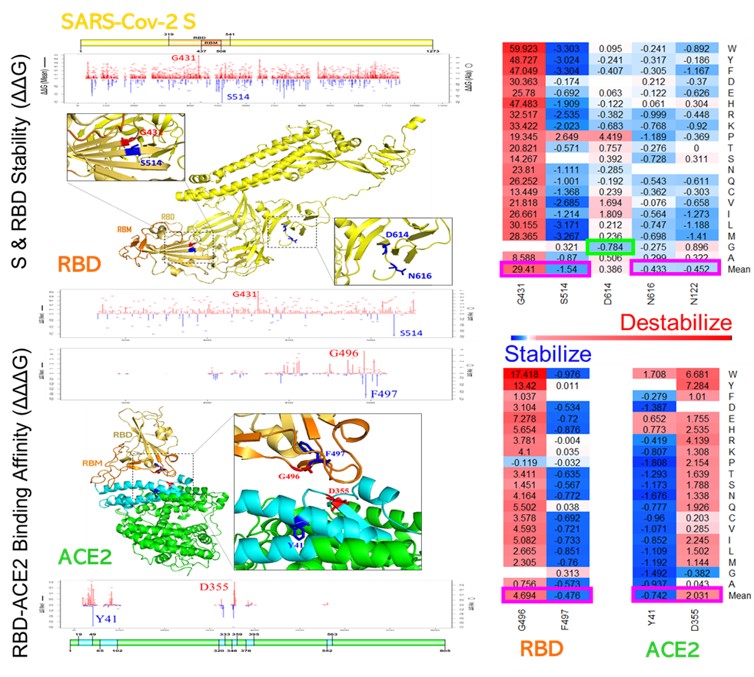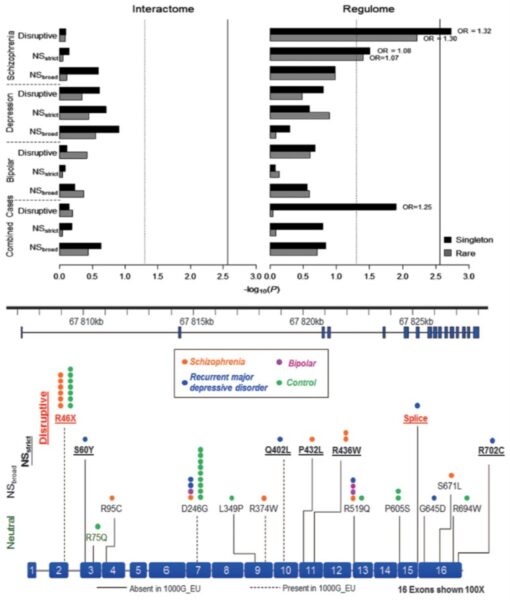Selected Papers

Briefings in Bioinformatics 2021 Mar 22;22(2):1239-1253. doi: 10.1093/bib/bbaa233.
Systemic Effects of Missense Mutations on SARS-CoV-2 Spike Glycoprotein Stability and Receptor Binding Affinity
Abstract: The spike (S) glycoprotein of SARS-CoV-2 is responsible for the binding to the permissive cells. The receptor-binding domain (RBD) of SARS-CoV-2 S protein directly interacts with the human angiotensin-converting enzyme 2 (ACE2) on the host cell membrane. In this study, we used computational saturation mutagenesis approaches, including structure-based energy calculations and sequence-based pathogenicity predictions, to quantify the systemic effects of missense mutations on SARS-CoV-2 S protein structure and function. A total of 18,354 mutations in S protein were analyzed and we discovered that most of these mutations could destabilize the entire S protein and its RBD. Specifically, residues G431 and S514 in SARS-CoV-2 RBD are important for S protein stability. We analyzed 384 experimentally verified S missense variations and revealed that the dominant pandemic form, D614G, can stabilize the entire S protein. Moreover, many mutations in N-linked glycosylation sites can increase the stability of the S protein. In addition, we investigated 3,705 mutations in SARS-CoV-2 RBD and 11,324 mutations in human ACE2 and found that SARS-CoV-2 neighbor residues G496 and F497 and ACE2 residues D355 and Y41 are critical for the RBD-ACE2 interaction. The findings comprehensively provide potential target sites in the development of drugs and vaccines against COVID-19.

Molecular Psychiatry 2018 May;23(5):1270-1277. doi: 10.1038/mp.2017.115.
Rare disruptive variants in the DISC1 Interactome and Regulome: association with cognitive ability and schizophrenia
Abstract: Schizophrenia (SCZ), bipolar disorder (BD) and recurrent major depressive disorder (rMDD) are common psychiatric illnesses. All have been associated with lower cognitive ability, and show evidence of genetic overlap and substantial evidence of pleiotropy with cognitive function and neuroticism. Disrupted in schizophrenia 1 (DISC1) protein directly interacts with a large set of proteins (DISC1 Interactome) that are involved in brain development and signaling. Modulation of DISC1 expression alters the expression of a circumscribed set of genes (DISC1 Regulome) that are also implicated in brain biology and disorder. Here we report targeted sequencing of 59 DISC1 Interactome genes and 154 Regulome genes in 654 psychiatric patients and 889 cognitively-phenotyped control subjects, on whom we previously reported evidence for trait association from complete sequencing of the DISC1 locus. Burden analyses of rare and singleton variants predicted to be damaging were performed for psychiatric disorders, cognitive variables and personality traits. The DISC1 Interactome and Regulome showed differential association across the phenotypes tested. After family-wise error correction across all traits (FWERacross), an increased burden of singleton disruptive variants in the Regulome was associated with SCZ (FWERacross P=0.0339). The burden of singleton disruptive variants in the DISC1 Interactome was associated with low cognitive ability at age 11 (FWERacross P=0.0043). These results identify altered regulation of schizophrenia candidate genes by DISC1 and its core Interactome as an alternate pathway for schizophrenia risk, consistent with the emerging effects of rare copy number variants associated with intellectual disability.
- Shaolei Teng*, Adebiyi Sobitan, Raina Rhoades, Dongxiao Liu, and Qiyi Tang* (2020) Systemic Effects of Missense Mutations on SARS-CoV-2 Spike Glycoprotein Stability and Receptor Binding Affinity. Briefings in Bioinformatics. Oct 2; doi: 10.1093/bib/bbaa233. PMID: 33006605; PMCID: PMC7665319. (*Corresponding author)
- Shaolei Teng* and Qiyi Tang* (2020) ACE2 enhance viral infection or viral infection aggravate the underlying diseases. Computational and Structural Biotechnology Journal. 2020; 18: 2100–2106. doi: 10.1016/j.csbj.2020.08.002 PMCID: PMC7409731 PMID: 32832038 (Review)
- Jing Zhang, Ruth Cruz-cosme, Meng-Wei Zhuang, Dongxiao Liu, Yuan Liu, Shaolei Teng, Pei-Hui Wang and Qiyi Tang*. (2020) Systemic and Molecular Study of Subcellular Localization of SARS-CoV-2 Proteins. Signal Transduction and Targeted Therapy. Nov 17;5(1):269. doi: 10.1038/s41392-020-00372-8 PMID: 33203855 PMCID: PMC7670843
- Yixin Xie, Chitra Karki, Dan Du, Haotian Li, Jun Wang, Adebiyi Sobitan, Qiyi Tang, Shaolei Teng, and Lin Li* Spike proteins of SARS-CoV and SARS-CoV-2 utilize different mechanisms to bind with human ACE2 Frontiers in Molecular Biosciences – Molecular Recognition. 2020; 7: 591873. doi: 10.3389/fmolb.2020.591873 PMCID: PMC7755986 PMID: 33363207
- Vidhyanand Mahase, Adebiyi Sobitan, Christina Johnson, Farion Cooper, Yixin Xie, Lin Li and Shaolei Teng* (2020) Computational Analysis of Hereditary Spastic Paraplegia Mutations in the Kinesin Motor Domains of KIF1A and KIF5A Journal of Theoretical and Computational Chemistry (JTCC), doi: 10.1142/S0219633620410035 Vol. 19, No. 06, 2041003
- Raina Rhoades, Fatimah Jackson, Shaolei Teng*. (2019) Discovery of rare variants implicated in schizophrenia using next-generation sequencing. J Transl Genet Genom 2019;3:1. https://doi.org/10.20517/jtgg.2018.26
- Michael C. Campbell, Bryan Ashong, Shaolei Teng, Jayla Harvey and Christopher N. Cross (2019) Multiple selective sweeps of ancient polymorphisms in and around LTα located in the MHC class III region on chromosome 6. BMC Evol Biol. 2019 Dec 2;19(1):218. doi: 10.1186/s12862-019-1516-y. PMID: 31791241
- Shaolei Teng, Pippa A. Thomson, Shane McCarthy, Melissa Kramer, Stephanie Muller, Jayon Lihm, Stewart Morris, Dinesh Soares, William Hennah, Sarah Harris, Luiz Miguel Camargo, Vladislav Malkov, Andrew M McIntosh, J. Kirsty Millar, Douglas Blackwood, Kathryn L. Evans, Ian Deary, David J. Porteous and W. Richard McCombie. (2018) Rare disruptive variants in the DISC1 Interactome and Regulome: association with cognitive ability and schizophrenia. Molecular Psychiatry, 2018 May;23(5):1270-1277. doi: 10.1038/mp.2017.115. Epub 2017 Jun 20. PMID: 28630456.
- Lisha Shao, Binyan Lu, Zhexing Wen, Shaolei Teng, Lingling Wang, Yi Zhao, Koko Ishizuka, Akira Sawa Hongjun Song, Guoli Ming and Yi Zhong. (2017) Disrupted-in-Schizophrenia (DISC1) protein disturb neural function in multiple disease-risk pathways. Human Molecular Genetics 2017 May 3. doi: 10.1093/hmg/ddx147. PMID: 28472294
- Lin Li, Zhe Jia, Yunhui Peng, Subash Godar, Ivan Getov, Shaolei Teng, Joshua Alper and Emil Alexov. Forces and Disease: Electrostatic force differences caused by mutations in kinesin motor domains can distinguish between disease causing and harmless mutations. Scientific Reports 2017; 7: 8237. PMID: 28811629
- Dondra Bailey, Mohammed Abul Basar, Sanjay NAg, Shaolei Teng, Atanu Duttaroy. (2017) The essential requirement of an animal heme peroxidase protein during the wing maturation process in Drosophila , BMC Developmental Biology 2017 Jan 11;17(1):1. doi: 10.1186/s12861-016-0143-8.
- Xuemin Wang, Peng Zhou, Stephanie Buggs, Shaolei Teng*. (2016) Genetic biomarker selection for obsessive-compulsive disorder by sparse representation based variable selection method. Journal of Psychiatry and Brain Science 2016;1(4): 1 ; DOI:10.20900/jpbs.20160015.
- Xin Li, Shaolei Teng*. RNA-Seq in schizophrenia. (2016) Bioinformatics and Biology Insights 2015:9(S1) 53–60 doi: 10.4137/BBI.S28992
- Jianping Zhang, Shaolei Teng, Cuncong Zhong, Bo Wang, Jie Wu. (2016) Current developments in RNA sequence analysis. Bioinformatics and Biology Insights 2015; 9(Suppl 1): 61–63.
- Zhenmin Ling, Yi Liu, Shaolei Teng, Zhen Kang, Jingjing Zhang, Jian Chen and Guocheng Du. (2013) Rational design of a novel propeptide for improving active production of Streptomyces griseus trypsin in Pichia pastoris. Applied and Environmental Microbiology 79(12): 3851-3855
- Hafumi Nishi, Manoj Tyagi, Shaolei Teng, Benjamin Shoemaker, Kosuke Hashimoto, Emil Alexov, Stefan Wuchty and Anna R. Panchenko. (2013) Cancer missense mutations alter binding properties of proteins and their interaction networks. PLOS ONE. 8(6): e66273.
- Shaolei Teng, Jack Y Yang and Liangjiang Wang. (2013) Genome-wide prediction and analysis of human tissue-selective genes using microarray expression data. BMC Medical Genomics, 6(Suppl 1):S10
- Dongxiao Li, Liangjiang Wang, Shaolei Teng, Guoguang Zhang, Lijia Guo, Qian Mao, Wei Wang, Min Li and Liang Chen (2012) Proteomics analysis of rice proteins up-regulated in response to bacterial leaf streak disease. Journal of Plant Biology 55:316-324
- Shaolei Teng, Hong Luo, Liangjiang Wang. (2011) Predicting protein sumoylation sites from sequence features. Amino Acids, 43(1):447-55.
- Shaolei Teng, Anand K. Srivastava, Liangjiang Wang. (2010) Sequence feature-based prediction of protein stability changes upon amino acid substitutions. BMC Genomics, Nov 2;11 Suppl 2:S5.
- Zhe Zhang§, Shaolei Teng§, Liangjiang Wang, Charles E. Schwartz, Emil Alexov. (2010) Computational analysis of missense mutations causing Snyder-Robinson syndrome. Human Mutation, Sep;31(9):1043-9. (§Co-first author)
- Shaolei Teng, Anand K. Srivastava, Charles E. Schwartz, Emil Alexov, Liangjiang Wang. (2010) Structural assessment of the effects of amino acid substitutions on protein stability and protein-protein interaction. International Journal of Computational Biology and Drug Design 3(4):334-49.
- Shaolei Teng, Petras Kundrotas, Thomas Madej, Anna Panchenko and Emil Alexov. (2009) Modeling effects of human SNPs on protein-protein interactions. Biophysical Journal 96(6): 2178-2188. (Recommended by F1000 Faculty Reviews)
- Shaolei Teng, Michonova-Alexova E, Emil Alexov. (2008) Approaches and resources for prediction of the effects of non-synonymous single nucleotide polymorphism on protein function and interactions. Current Pharmaceutical Biotechnology Apr;9(2):123-33.
- Chaoqun Huang, Jialiang Zhou, Shiliang Wu, Yuxi Shan, Shaolei Teng, Long Yu (2004) Cloning and tissue distribution of the human B3GALT7 gene, a member of the β1,3-Glycosyltransferase family. Glycoconjugate Journal 21, 267–273.
- Shaolei Teng*. Chapter 1. NGS for Sequence Variants. (2016) Translational Biomedical Informatics: A Precision Medicine Perspective. Editors: Bairong Shen, Haixu Tang and Xiaoqian Jiang. Springer. PMID: 27807741 DOI: 10.1007/978-981-10-1503-8_1
Conference Proceedings
- Shaolei Teng, Hong Luo, Liangjiang Wang. (2010) Random Forest-Based Prediction of Protein Sumoylation Sites from Sequence Features. In: BCB ’10 Proceedings of the First ACM International Conference on Bioinformatics and Computational Biology. pp. 120-126. Association for Computing Machinery (ACM)
- Shaolei Teng, Anand K. Srivastava and Liangjiang Wang. (2009) Biological Features for Sequence-Based Prediction of Protein Stability Changes upon Amino Acid Substitutions. In: IJCBS ’09 Proceedings of the 2009 International Joint Conference on Bioinformatics, Systems Biology and Intelligent Computing, pp. 201-206. IEEE Computer Society.